Content
- 1 Characteristics of species of tree peonies
- 2 What do tree-like peonies of yellow varieties look like (with photo)
- 3 The best varieties of red tree peonies for the Moscow region
- 4 Winter-hardy varieties of white tree peonies (with photo)
- 5 Tree peonies in garden landscape design (with photo)
- 6 Classification of varieties of tree peonies
- 7 Varieties of white tree peonies
- 8 Red varieties of tree peonies
- 9 Purple, violet, lilac varieties of tree peonies
- 10 Pink tree peonies
- 11 Yellow treelike peony varieties
Characteristics of species of tree peonies
There are 4 known species of these plants:

Tree peony in the photo
Tree peony (Paeonia suffruticosa), which gave the name to the whole group
Three types of semi-shrub peonies:
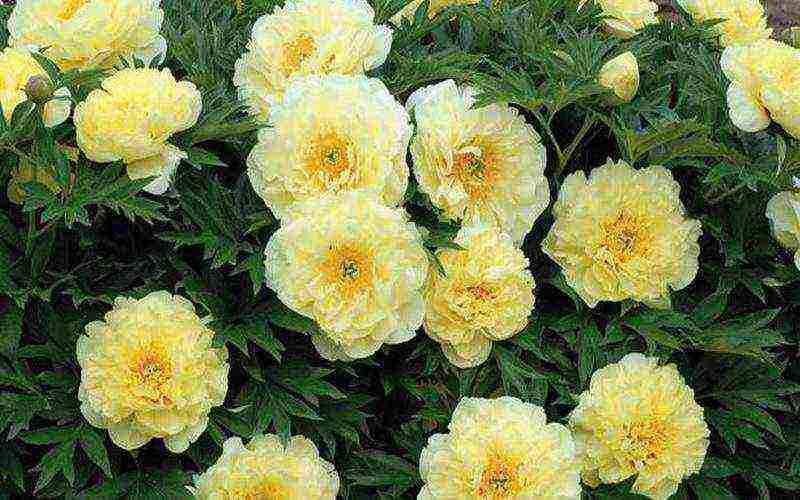
Yellow peony (P. lutea)
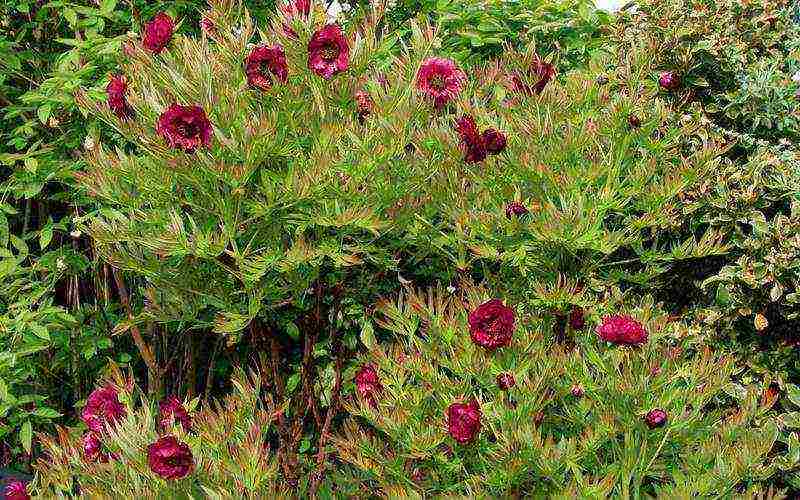
Delaway Peony (P. delavayi)

Potanin's peony (P. potaninii)
These photos show the types of tree peonies:
Tree peony, or semi-shrub (P. suffructicosa, aka P. montan and P. arborea, is a polymorphic species, which includes all garden forms of tree peonies.
These are exceptionally beautiful shrubs with a height of 1.5 to 2 m with large, bright green, double-pinnate leaves. The buds are pale pink. The flowers are white, pale pink or intense pink with a dark magenta spot at the base. Flower diameter 16-20 cm. Stamens with bright yellow anthers are clearly visible. The fruit is a leaflet in non-double carpels, as a rule, 5 carpels, in double ones - from 6 to 10. Each carpel has 6-14 large black shiny seeds.
See how semi-shrub tree peonies look in these photos:
A velvety fuchsin spot at the base of each petal and numerous large bright yellow stamens make the flower even more spectacular. On one bush, from 50 to 100 flowers can bloom at the same time. Flowers are non-double, semi-double, double. Duration of flowering of one bush is 12-14 days. In the middle lane, tree-like peonies bloom at the end of May, usually on the 23-24th (the timing depends on weather conditions: if spring is early, peonies can start blooming on May 17; the latest flowering was observed on June 3). Non-double varieties are the first to bloom, terry varieties - three to four days later. After one to two weeks, yellow-flowered semi-shrub peonies begin to bloom.
In semi-shrub species - yellow peonies, Delaway and Potanin - the shoots are straight, low-branched, reaching a height of 2 m.The leaves are large, dvadratriychatye, up to 55 cm in length with a petiole length of 20 cm.
When describing treelike peonies, it is worth noting that in the middle lane these plants very often behave like herbaceous plants: in winter, the entire aboveground part dies off, and grows back by the end of the season. Unlike the tree-like peony, which has only one flower on the shoot, the yellow and Delaway peony often have 3-4 flowers.
Flowers 4-9 cm in diameter. The yellow peony has bright yellow petals, the Delaway has chestnut or dark chestnut. The fruit of yellow and Delaway is a bare leathery leaflet with 3-5 carpels. Freshly harvested seeds are large, dark brown, smooth. Both species bloom two weeks later than the tree peony, which makes it possible to extend the flowering of peonies in your garden. First, non-double varieties bloom, then double ones. They usually bloom for about two weeks.
In all tree peonies, the first circle of stamens around the pistil is sterile.These stamens grow together and form the so-called staminodial disc, which tightly closes the pistils at the bud stage.
As a result of interspecific and intraspecific hybridization, numerous varieties of peonies were obtained, which are subdivided into several groups: the Sino-European - with double flowers, the Japanese - with non-double and semi-double flowers, and the yellow peony hybrid.
As you can see in the photo, the flowers of tree-like peonies of the Sino-European group (most varieties were imported to Europe from China) have very large, double, dense petals, and under their weight the branches droop strongly, which reduces the decorative effect of the bush during the flowering period:
In Japan, unlike China, peonies with non-double or semi-double flowers are grown. The main characteristic of Japanese tree-like peonies is light, smaller flowers that rise above the leaves, and the presence of strong peduncles. The color range of flowers is wider. The third group consists of hybrids of yellow peony, Delaway and Potanin with different forms of P. suffruticosa. These hybrids are currently the most popular. Breeders have received a very rich range of colors of hybrids - from pure yellow to chestnut with a variety of strokes that give the flowers the greatest attractiveness.
Below you can find a photo and description of the varieties of tree peonies, the most popular in Russian gardens.
What do tree-like peonies of yellow varieties look like (with photo)
‘Academician Sadovnichy’... Height 70-100 cm, the flower is located at the level of the upper leaves. The flower is semi-double, cup-shaped, the petals are bright yellow, with a dark purple spot at the base. The filaments of this variety of yellow treelike peony are red-purple, the stigma is creamy, the staminodial disc is well pronounced. One of the best domestic varieties.
‘Kuindzhi’... Hybrid variety. The flowers are not double, the petals are wide, bright yellow, with a red spot at the base. Filaments are yellow, staminodial disc is red, stigma is yellow.
Pay attention to the photo - this variety of tree peony has flowers on a strong peduncle above the leaves:
'Souvenir de Maxime Cornu' - 'Souvenir de Maxime Cornu'... The flowers are densely double, the petals are bright yellow with a pinkish-cream border along the edge. The flowers are very heavy, the pedicels droop. The bush is about 1 m tall. They have a pleasant aroma. They are well preserved in cut.
Below are photos and descriptions of varieties of tree-like peonies in red.
The best varieties of red tree peonies for the Moscow region
‘Vesuvian’ - ‘Vesuvius’. The flowers are large, double. The petals are crimson-red, numerous. Flowers with pale yellow anthers and short red filaments. Pistils are pale green with purple stigmas. Bush up to 75 cm tall.
‘Vladimir Novikov’... The petals are red-beetroot-fuchsin, with an almost dark purple spot at the base, the edges of the petals are notched, corrugated. The staminodial disc is light with crimson veins, the filaments are crimson with bright yellow anthers. There are 5 or more pistils; stigmas are pale pink. The bush is 130-150 cm high, spreading. This tree-like peony, suitable for the Moscow region, has dark green leaves.
‘Gauguin’ - ‘Gauguin’... The flowers are large, crimson-red. Petals with dark crimson veins, along the edge with a magenta shade. The staminoid disc is dark pink. The stamens are large, with dark red filaments. The height of the bush is up to 1.2 m.
'Coral'... Hybrid variety. The flowers are non-double, the petals are red-purple, with a dark red spot at the base. Filaments are purple; staminodial disc and stigma are pink. This is one of the best varieties of tree peonies over 100 cm in height.
'Peter the Great'... The flower is semi-double, 20 -25 cm in diameter, wide open. The petals are lilac-beetroot-colored with purple veins. Pistils from 9 to 13, stigmas are bright crimson. The staminodial disc is weak. The filaments are pale lilac in color.Bush 130-150 cm high, spreading, multi-stemmed.
'Stephen'... The flowers are non-double, 18-20 cm in diameter. The petals are crimson with lilac veins and a dark purple spot at the base. The staminoid disc is almost invisible. There are five to six carpels, pistils (5-6) with crimson stigmas, filaments crimson at the base. Bush 90-100 cm high, sparse, sprawling.
‘Vadim Tikhomirov’... The flower is non-double, from 11 to 15 cm in diameter. The petals are pink, with a small dark crimson spot, with corrugated edges. The staminoid disc is crimson. Filaments are crimson with bright yellow anthers. Pistils with raspberry stigmas. Bush 1.5 m high, multi-stemmed. The leaves are dark green.
‘Hoffman’... The petals are pale pink, with a pale pink spot. The staminodial disc is white at the base, pale crimson above. Pistils with light pink stigmas, light filaments. Shrub up to 1.5 m high, multi-stemmed. The leaves are bright green.
'Irina'... The flower is semi-double, the lower petals are large, in the center - smaller, form an inner circle with a diameter of 17 cm. The petals are dark salmon with a dark magenta spot at the base. The staminoid disc is violet-red; stigmas of pistils and filaments are bright crimson. Shrub up to 170 cm high, multi-stemmed.
'Muse'... The petals are crimson-pink, forming four circles; outer - large, concave, inner - spherical, smaller. This one of the best varieties of tree peonies for the Moscow region has practically no spots on the petals. The staminoid disc is crimson, there are five pistils, the stigmas are pink, the filaments are crimson with bright yellow anthers. The bush is 120-130 cm high. The leaves are bright green.
‘Smolin’... The flower is semi-double, multi-row, 22-25 cm in diameter. The petals are pale pink, with a bright purple spot at the base. The staminoid disc is light. The stigma of the pistils is pink-yellow, the filaments are crimson at the base. The bush is 120-130 cm high, spreading, some shoots lie down. The leaves are green with a brown tint.
'Marianne'... The petals are arranged in three rows, pale salmon, with a dark crimson spot, the edges of the petals are corrugated. The filaments are crimson, the stigmas of the pistils are pale pink. Beet-colored staminoid disc. The bush is compact, 120-140 cm high. The leaves are bright green.
Below are photos and descriptions of varieties of white peonies.
Winter-hardy varieties of tree-like peonies in white (with photo)
'August'... The flower is goblet, retains its shape until the end of flowering. Petals (13-15 in number) are pure white, with a light pink, almost imperceptible spot at the base. Filaments are white; six pistils, stigmas light yellow, staminodial disc light pink, reaching 1/3 of pistil height. The height of the bush of this winter-hardy variety of tree peonies is 120-130 cm. The leaves are large, bright green.
‘Anastasia Sosnovets’... The flower is non-double, the petals are two-row, slightly corrugated along the edge, white, with a bright magenta spot at the base. Filaments are white, closer to the anthers with a raspberry tinge. Five pistils, stigmas light yellow; the staminodial disc is light. Bush up to 1.5 m tall, compact. The leaves are medium-sized, with a dark green tint.
'Spring Waltz'... The petals are pure white, with an almost black spot at the base, the filaments are white, the staminodial disc is red-purple. The height of the bush is up to 120 cm.
‘Vorobievsky’... The flower is non-double, goblet, retains its shape until the end of flowering.
As you can see in the photo, this winter-hardy variety of tree-like peonies has almost pure white petals, only at the base there are thin magenta lines:
The staminoid disc is white. Filaments are light lilac below, white above; five pistils, stigmas light yellow. The bush is up to 1.5 m high. The leaves are green.
'Maria'... The flower is semi-double, the petals are two-row, pure white, slightly wavy along the edge. Filaments are light. There are five pistils, the stigmas are light, the staminodial disc is white, slightly colored at the apex.The bush is 120-130 cm high, spreading. Leaves are light green with an anthocyanin border.
'Tatyana'... The flower is semi-double, retains its shape until the end of flowering. Petals 2-3-row, white, with a small crimson spot at the base. The staminodial disc is white, the filaments are crimson; 5-6 pistils; stigmas light yellow. The bush is 100-120 cm tall, spreading, multi-stemmed. The leaves are small, delicate, green, with anthocyanin coloration.
Here you can see photos of tree-like peonies, the description of which is presented on this page:
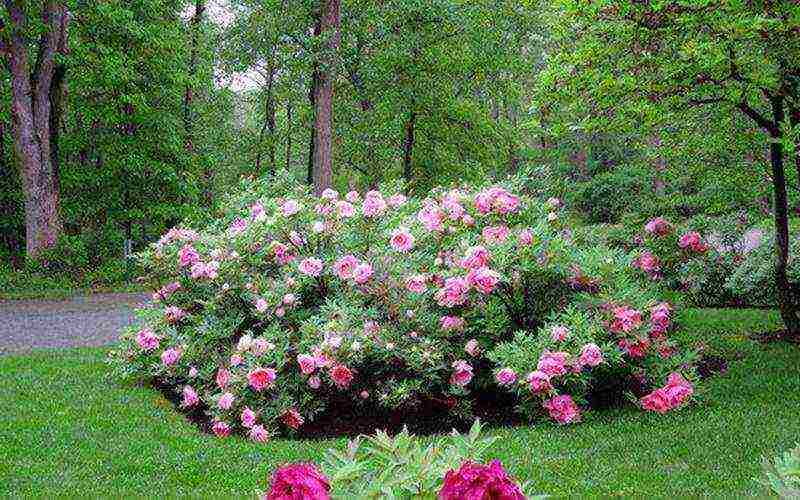
Tree peony 'Irina' in the photo
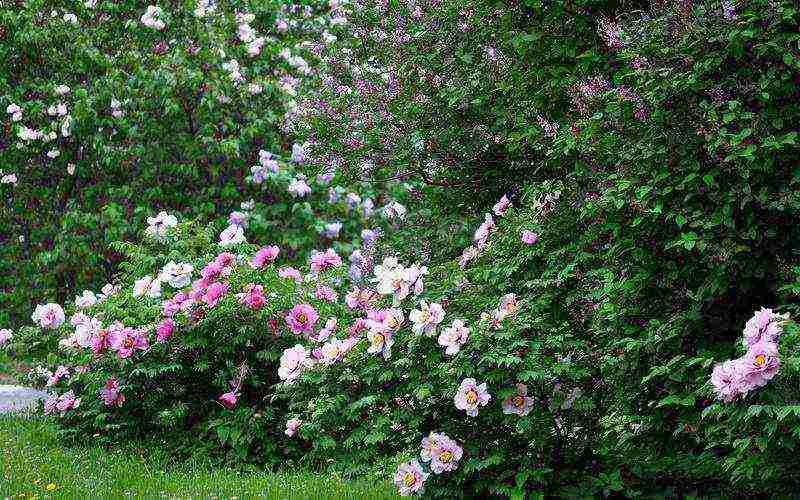
'Stefan' tree peony pictured
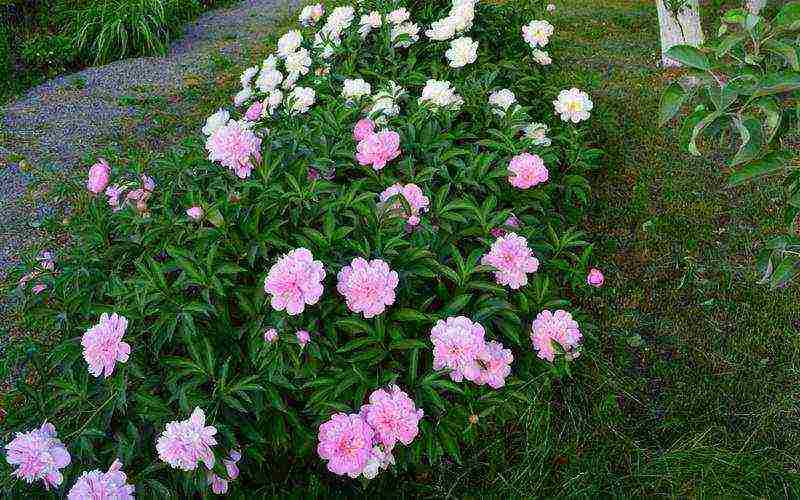
Hoffmann's tree peony photo
Tree peonies in garden landscape design (with photo)
Tree peonies in landscape design are one of the most promising crops for landscaping, since with proper agricultural technology they can grow in one place for 50 or more years. Peonies can be recommended both for personal plots and for landscaping squares and parks. Among perennial plants, there are few that could compete with them in longevity and unpretentiousness. The buds of tree-like peonies resemble a rose, and during the flowering period the plants fill the garden with an unusual aroma, delight us with the beauty and variety of flower colors. Peonies can be used to create rock gardens, large landscapes, to decorate parks and garden plots. They can be planted both in groups and singly on the ground. Peonies look spectacular against the background of conifers (for example, silver fir trees) or next to architectural structures.
See how beautiful tree peonies in the garden are in these photos:

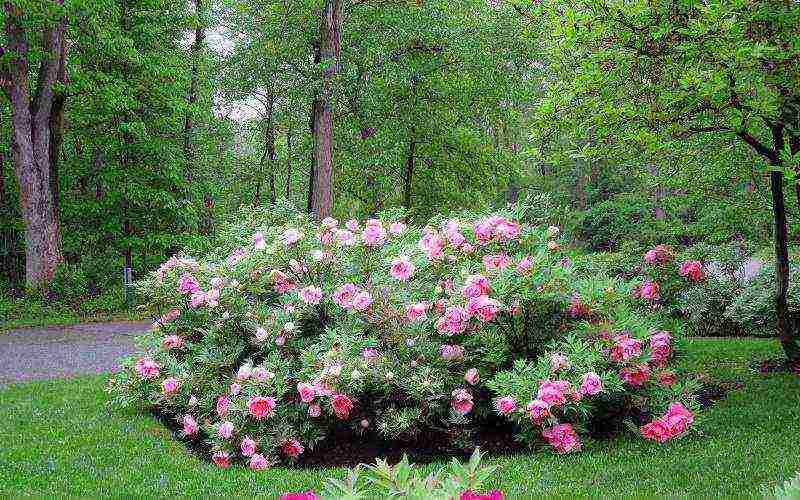
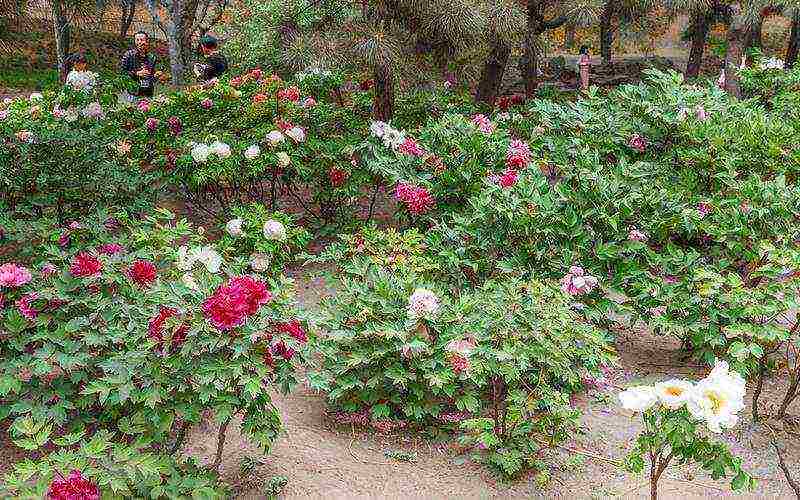
These crops bloom at the same time as lilacs and chestnuts - it is no coincidence that many gardeners plant them nearby.
Between the bushes of peonies, you can plant woodlands, tulips, daffodils, crocuses. When these early spring plants have faded, the leaves of the regrown peonies will completely cover them.
In large parks, peonies are used to get colorful spots, but it is undesirable to plant them in a continuous strip on the lawn. When creating a landscape composition, it is necessary to think in advance about the combination of peonies in color and size and general appearance, and not only during flowering, but also in the summer-autumn period. Ceremonial compositions are usually created from one variety of peonies. In mixed plantings, it is desirable to create separate groups from non-double and double peonies.
Despite the fact that the flowering of individual forms is short-lived, skillfully picking up tree-like peonies of various varieties in the garden, you can create a composition of continuous flowering. The first, in the 20th of May, will bloom non-double varieties of tree peony, in a few days the baton will be picked up by terry varieties, and in a couple of weeks the flowering of yellow peony will begin. When the tree-like peonies fade, they will be replaced by early flowering varieties of herbaceous peonies. As a result, peonies will adorn your garden from mid-May to late June.
These photos show tree peonies in the landscape design of city parks and private gardens:
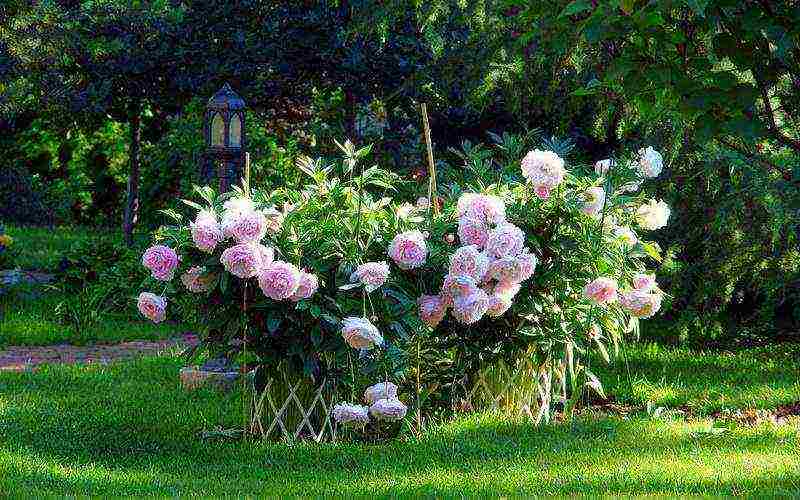

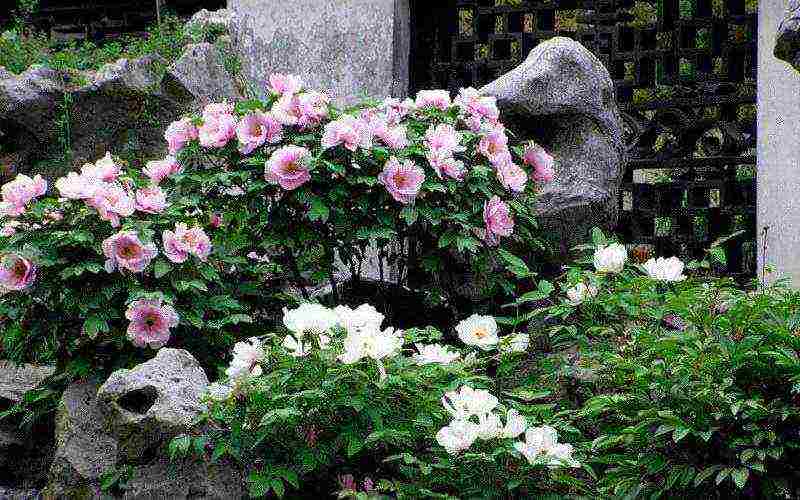
Rate the article:
(12 votes, average: 4.6 out of 5)
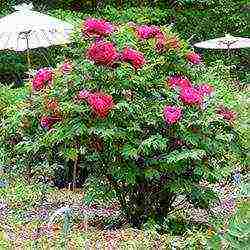 Treelike peonies open the fragrance season of large-flowered solitary perennials. Online store catalogs offer up to 600 different varieties of this delightful plant. The proposed article will help you understand their classification and, with the help of high-quality photos, choose the right one. Get acquainted with the names of varietal variations and their descriptions, choose a place in the garden for planting a peony and enjoy its aroma and delicate colors of innocence.
Treelike peonies open the fragrance season of large-flowered solitary perennials. Online store catalogs offer up to 600 different varieties of this delightful plant. The proposed article will help you understand their classification and, with the help of high-quality photos, choose the right one. Get acquainted with the names of varietal variations and their descriptions, choose a place in the garden for planting a peony and enjoy its aroma and delicate colors of innocence.
Tree peony - distinctive features
The colossal variety of varieties and varieties of tree peonies is divided into three garden groups. This type of peony, seen and introduced into the culture in the Middle Kingdom, is otherwise called semi-shrub.It has a number of differences from herb that you should know before purchasing in order to provide it with proper care.
- Woody stems. They cannot be cut into a stump in the fall, as is done with herbaceous ones. For the winter, the bushes of tree peonies are wrapped in agrofibre, and cut off after the snow melts. A transplant is planned for the fall, and vaccination is chosen as a breeding method.
- The height of the bush. Every year, the tree-like peony increases its habit, therefore it requires more space.
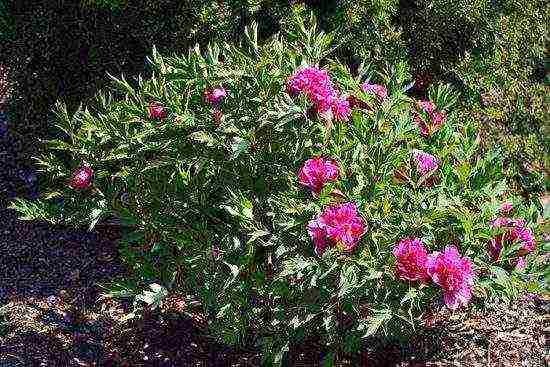
Tree peony requires specific care
- The original shape of the flowers. It looks most impressive in a single planting in front of conifers or a dark-leaved tree such as a horse chestnut.
Advice. To use a peony to create a romantic corner in the garden, plant it against the background of the light wall of the gazebo, surrounded by small-flowering ground covers.
Sino-European peonies - drooping giants
In the group of Chinese-European peonies, selection is made for the size and doubleness of the flowers. They are much larger than others, have dense petals of all shades of rose, peach, salmon, lilac. However, the flowers are so heavy that the stems droop during flowering, sharply reducing the decorative effect of the culture.
The following varieties of Chinese-European peonies are of interest:
- Red giant. The bush grows 180-190 cm. A flower of expressive coral color, crown shape, size 16 × 7 cm. The variety is distinguished by active growth and multi-flowering, blooms towards the end of the season. Slightly drooping.
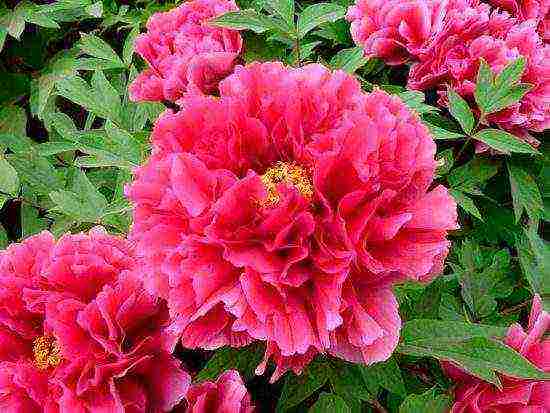
Red giant
- Transparent dew. A medium-sized variety (up to 150 cm) with pronounced double flowers 18 × 7 cm in size. The color is pale lilac in the center and delicate mother-of-pearl on the periphery. It blooms late and has a very delicate odor.
- Blue sapphire. Giant, up to 25 cm, flowers on low stems. The color is pale pink, the name of the variety is given for the distinct bluish tint of the edges of the petals, which appears with proper care. Strongly drooping, requires strengthening and a garter.
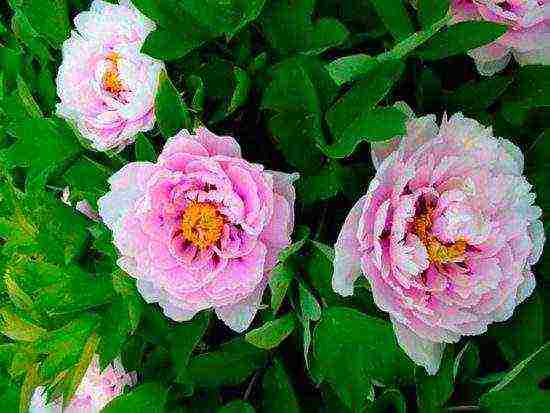
Blue sapphire
Other varieties should be mentioned:
- Taoist temple - blood-scarlet semi-double;
- Green ball - with Chinese cabbage-colored petals;
- Peach under the snow - with the shape and color of a lotus;
- Pink lotus - salmon color with a bright center of black and yellow stamens.
Attention! Peonies of all varietal groups love slightly alkaline soil, therefore, before planting, the soil must be filled with dolomite flour.
Japanese peonies are modest beauties
Tree-like peonies of Japanese selection are good for increased winter hardiness, which is in demand in regions with a harsh climate. These are non-double and semi-double plants with somewhat smaller flowers, but light and less prone to drooping. The common form of the flower is anemone. Among the "Japanese" the following varieties have gained popularity.
- Gold placer. Each pale yellow petal is framed along the contour with a salmon-colored border, forming a lace flower with whimsical pink lines. Size 20 × 7 cm. Blooms late.
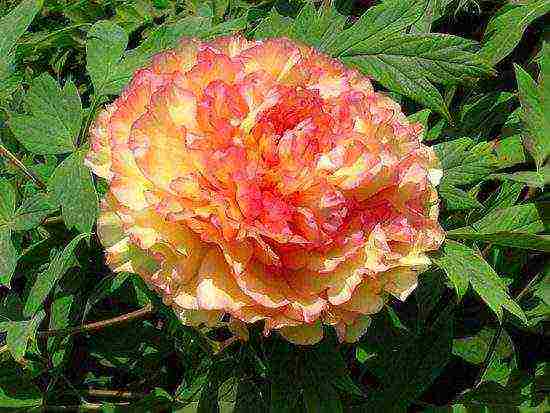
Gold placer
- Koshino-yuki. It is considered the best white variety in the world. The size of the flower is 20 × 7 cm. Initially greenish, when blooming, the bud takes the form of ivory, and then - untouched snow.
- Black Panther. A low, up to 110 cm, shrub decorated with deep burgundy flowers with a golden center, 19 × 8 cm in size.
- Shima-nishiki. One of the most spectacular varieties. The compact bush is strewn with large (18 × 8) flowers of such a color, as if milk was poured into strawberry jam and stirred a little.

Shima-nishiki
Such varieties also look great in the garden:
- Yellow Yao - with pale cream strongly convex flowers;
- Midday heat - unusual for lemon-colored peonies, sometimes blooms again in August;
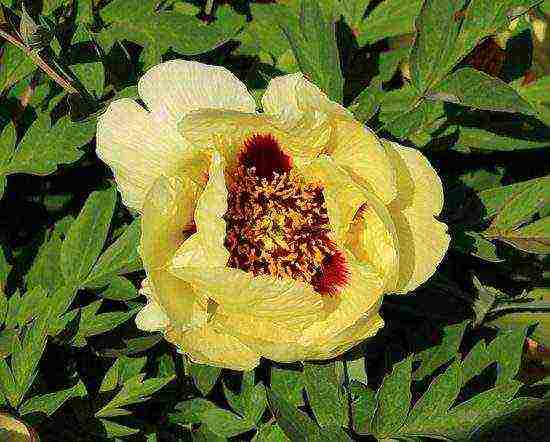
Midday heat
- Primavere is like a lemon canary fluffed up with feathers;
- Two sisters - with unique two-tone flowers, from tender pink on one side to deep purple on the other.
Advice. Peonies are very moisture-loving; it is almost impossible to fill them in well-drained soil.Give each bush a whole bucket of water - and you will be rewarded with luxurious flowering.
Delaway peonies - solar hybrids
This group of tree peonies is represented by hybrids of two types: yellow and Delaway. As a rule, they have a simple non-double flower, close to the original form, and a color of yellow shades. Popular are:
- Academician Sadovnichy (Russia) - the color of butter with a raspberry "signal" inherited from the wild form at the base of each petal.
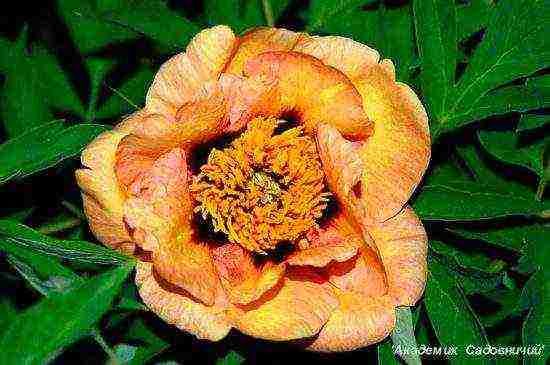
Academician Sadovnichy
- Souvenir de Maxime Cornu (France) is an unsurpassed densely double flower, pale yellow with carmine edging of petals.
Peonies of domestic selection
Professionals of the Moscow State University Botanical Garden and amateur flower growers have bred many varieties of peonies with excellent decorativeness and the ability to withstand Siberian or Far Eastern winters. Among them are especially good:
- Anastasia Sosnovets - small (11x5 cm), but spectacular white two-row flowers with bright spots of magenta;
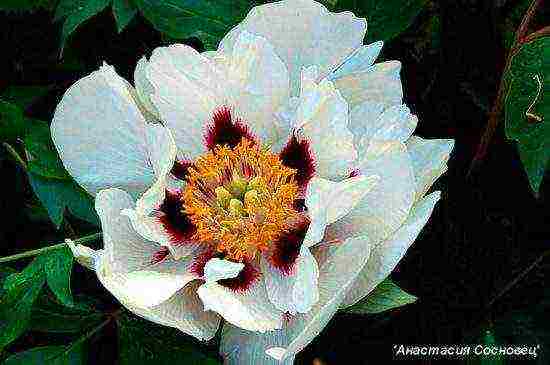
Anastasia Sosnovets
- Kuindzhi - elegant tall (up to 120 cm) bush with light foliage, creamy yellow flowers;
- Nikolay Vavilov - with wide (up to 20 cm) simple purple flowers;

Nikolay Vavilov
- Titus Trofimov is a semi-double pink flower, the color intensity of which increases towards the center;
- Julia Drunina - scarlet petals with a blueberry spot at the base.
In terms of decorativeness, the tree peony has few competitors. A large, well-groomed shrub with glossy foliage is impressive even outside the flowering period. The grandiose world collection of tree peonies allows you to choose a flower of any color and degree of terry for your garden.
Tree peony: video
Author of the publication
0 Comments: 100Publications: 6958Registration: 05-07-2015
|
A place |
Name |
Characteristics in the rating |
Peonies are flowers that are especially popular with gardeners. These unique plants are distinguished by their beauty, vibrant color and incredible aroma. In addition, they are perennial and require a one-time planting. There are about 34 species of peonies and more than 5,000 different varieties in the world (you can find photos of most of them on the Internet). In China, these flowers are considered imperial, in Japan - a symbol of prosperity. Peonies are common in many countries around the world. When choosing a variety, you should definitely take into account its origin. If the seeds are brought from abroad, then it will be extremely difficult to grow them in Russia due to the strong difference in climatic conditions and soil. Therefore, modern breeders develop varieties that will perfectly adapt on the territory of our country. There are many different factors to consider when choosing peonies:
- Variety... There are three of them: herbaceous, tree-like and ITO-hybrids. The first type is unpretentious in care, requires hilling before cold weather, and grows quickly. The second one can grow up to 100 years in one place without transplantation, in winter it sheds its leaves, it does not need to be cut off, but the first 5 years, growth is observed very slowly. Ito-peonies are artificially bred flowers that combine the best properties of the first two types, but are much more expensive in cost.
- Place of cultivation... Considering how large the territory Russia occupies, it is not difficult to guess that, depending on the region, specific varieties of peonies should be chosen. On sale you can find peonies for the Middle Belt, Moscow region, Siberia, etc. But many varieties are resistant to any weather conditions.
- Appearance. Of course, all peonies are beautiful in their own way, but every gardener can choose a variety to his taste. Someone likes to grow bright red flowers, someone likes delicate pink ones. The varieties differ not only in color, but also in the shape of the bud, the height of the bush. Photos and descriptions of each of them are on the packaging of the planting material (the flowering period is also indicated there, etc.).
We have selected the best varieties of herbaceous, treelike and ITO peonies. When compiling the rating, the following characteristics were taken into account:
- whimsical care;
- appearance;
- aroma;
- flowering period;
- landing conditions.
The best herbaceous varieties of peonies
Herbaceous peonies belong to the shrub type, they are the most numerous group. There are over 4500 varieties in total. Their main difference is unpretentiousness when growing. It is worth planting such a peony only once and it will delight the eye every year for a long time without needing a transplant. In addition, this species requires very rare but abundant watering. The flowers are usually large in diameter and smell luxurious. The bushes look great both in flower beds and separately. Below are the best varieties of herbaceous peonies with descriptions and photos.
5 Raspberry Sunday 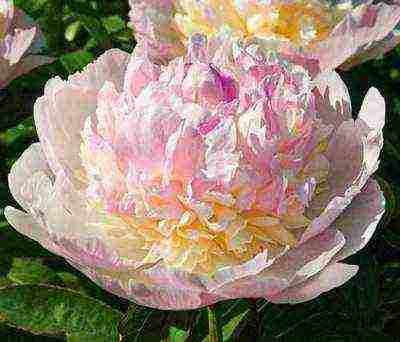 Unique color
Unique color
Average price:
280 RUB
Rating (2018):
4.5
Raspberry Sunday makes you fall in love at first sight. The multifaceted shade of pink in the middle gradually turns into cream with yellowish accents at the edges of the bud. It blooms early for several weeks. An equally important distinctive feature of the variety is its aroma, reminiscent of the smell of roses. Peony flowers are larger than average in size (18 cm). Raspberry Sunday is a real decoration for any garden. It is also often used in bouquet arrangements.
The peony bush is compact with bright, beautifully shaped leaves and strong stems. Its maximum height is 1 meter. It grows in one place for many years, not whimsical to care for. For landing, you should choose a well-lit place, because the variety loves the sun's rays. The buds should not be higher than 3 cm above the surface. The main advantages: an unusual color combination, attractive appearance, not capricious in care, tolerates subzero temperatures well, good reviews from gardeners.
4 Miss America  Ideal for cutting, large flower diameters
Ideal for cutting, large flower diameters
Average price:
850 RUB
Rating (2018):
4.6
Rich yellow stamens and snow-white petals - such an incredible combination is presented in the inflorescences of the Miss America variety. The diameter of the bud can reach as much as 25 cm! Huge white flowers on a lush bush with bright green foliage will please every gardener. Miss America will perfectly complement any landscape design. Unlike most herbaceous peonies, this variety is quite capricious when planting and caring for. It should be planted away from buildings and groundwater. Most often grown for cutting, because retains a presentable appearance for a long time and fills the room with a very pleasant smell.
Flowering is average in duration, observed from May to June. An important feature - during cold weather, it does not need shelter and calmly tolerates them. The peony has strong stems and a developed root system. It also grows rapidly. The bushes are quite compact in size. It occurs naturally in Siberia, Transbaikalia, etc. Main advantages: suitable for cutting, large diameter of flowers, very beautiful appearance of the bush and buds, developed root system, strong stems.
3 Duchesse de Nemours 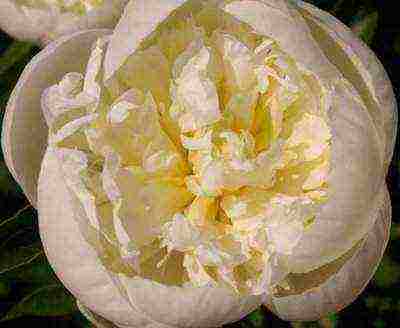 Excellent cold resistance
Excellent cold resistance
Average price:
650 RUB
Rating (2018):
4.7
"Duchesse de Nemours" belongs to the classic varieties of peonies and is one of the most common among them. The snow-white shade of the buds with a green tint at the beginning of flowering gradually changes to pearl towards the end. Most often, this type is used when decorating the territory. Its scent fills the entire area and resembles the delicate scent of lily of the valley. It is also very useful for cutting because keeps "fresh" for 10 days. The bush reaches one meter in height and has very lush, spreading foliage.
"Duchess de Nemours" blooms for only 20 days, but at this time the garden is noticeably transformed. Terry buds reach a diameter of 16 cm. A distinctive feature of the variety is shade and frost resistance.It tolerates cold well and is adapted to a wide variety of climates, ideal for growing in the Moscow region. An important point when planting is that the kidneys should be at surface level. The better and more often you take care of the peony, the more beautiful and magnificent it will bloom. Main advantages: excellent winter hardiness, beautiful snow-white bud, very lush foliage, delicate pleasant aroma.
2 Shirley Temple 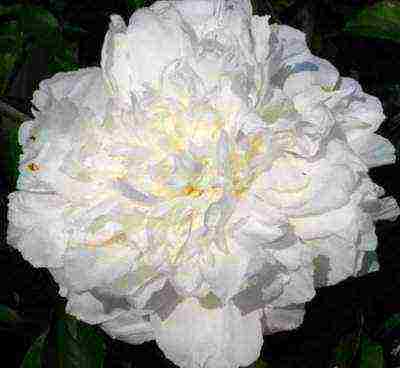 Beautiful buds
Beautiful buds
Average price:
445 RUB
Rating (2018):
4.8
Another popular cultivar with the most beautiful flowers - "Shirley Temple" - is named after the smallest American actress-winner of the "Oscar". He himself is distinguished by spherical buds of a pale pink color. Another feature of this variety is the color change of flowers as it blooms (by the end of the season, they turn white). The maximum height of the bush is 90 cm, and the diameter of the flowers reaches 20 cm. It is distinguished by lush bright foliage. Care is very simple, the plant is not whimsical enough.
Planting lasts from August to October. Shirl Temple blooms from May to June and pleases the eye until autumn. When planting, it is necessary to fulfill a number of conditions: place the seedlings close to the surface and treat the soil with fertilizers. Before cold weather, you should cut off the stems and cover the plant with peat or compost. In one place the bush grows for a very long time, takes root in different climatic conditions. Advantages: beautiful appearance, large buds, long flowering period, easy care and growing.
1 Sarah Bernhardt 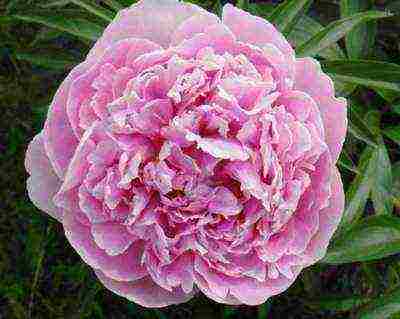 The most popular
The most popular
Average price:
260 RUB
Rating (2018):
4.9
Sarah Bernhardt is one of the most widespread varieties and a true legend among decorative crops. Bred by breeders in the 19th century, it is still highly sought after. It features huge buds (20 cm in diameter) and a wide variety of tones. Another advantage is that the flowers exude a rich aroma. Unlike many other varieties, "Sarah Bernhardt" also has beautiful foliage - each leaf is framed with a silver border. The color of the buds is very beautiful - raspberry pink. The bushes themselves are quite tall and strong.
The flowering period begins in the second half of June. When growing, no support is required, because the stems never tilt to the ground under the weight of the buds. When planting, which is usually carried out in spring, the plant requires a large hole due to the developed root system, and the buds must be located at a distance of 3-5 cm from the surface. At the end of the season, the peony is cut and left to winter. By the way, the variety tolerates Russian cold weather perfectly. Blooms in one place from 30 to 50 years. Advantages: legendary variety, easy to care for, fast growth, well adapted to the Russian climate, beautiful buds.
The best tree varieties of peonies
Tree peonies are distinguished by weighty branches up to 2 meters high. Unlike herbaceous species, this species does not need to be cut off before wintering - the plants themselves will shed their foliage. But they also have a minus - rather slow growth. The tree-like peony has a hard, tree-like stem. Another important feature is the flower diameter. Here it reaches as much as 30 cm. Often the buds are painted in several shades at the same time. Huge beautiful inflorescences of bright flowers perfectly decorate the garden and vegetable garden. There are about 500 varieties of tree peonies in total. The rating includes the best of them. Below you can find a description and a photo of each variety.
3 Green Jade 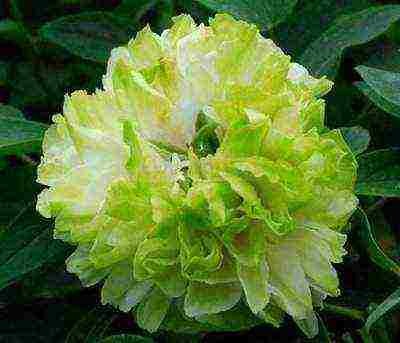 Very beautiful inflorescences
Very beautiful inflorescences
Average price:
1200 RUB
Rating (2018):
4.7
The unique Green Jade variety differs from most others. It has large inflorescences of a pale green hue and powerful woody stems. Peony foliage consists of oval soft leaves with a shiny sheen. They grow in height up to 1.5 meters. The bud is different in shape - inside the petals are very tight to each other. Another feature is rapid growth.The variety itself is quite rare, but very popular. Of course, its main feature is the incredible beauty of the flowers. Flowering occurs in May-June for an average of 2 weeks.
Requires cultivation in an area protected from the winds and with direct exposure to rays. The ideal climate for this variety is hot summers and cold winters (for example, Moscow region). In the first years after planting, it requires shelter for the winter. Often used in landscaping sites. Main advantages: beautiful buds, excellent decorative effect, resistance to negative factors, unusual color.
2 Coral Altar 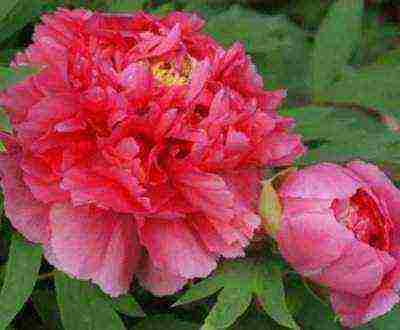 Disease and pest resistance
Disease and pest resistance
Average price:
450 RUB
Rating (2018):
4.8
Peony "Coral Altar" is a very popular variety. Its appearance is liked by most gardeners. It grows to a height of 150 cm, has unusually shaped petals and thick stems. Inflorescences perfectly combine shades from coral to white. In general, they look pale pink. The diameter of the buds reaches 20 cm. During flowering, the peony pleases not only with beautiful flowers, but also with a pleasant sweetish aroma. The buds are crown-shaped. Does not require shelter before wintering.
The variety is very resistant to diseases and pests. It is not very picky about the soil, but it grows better on fertile lands. With constant exposure to sunlight, the plant will decorate the garden with a large number of luxurious buds. Landscape designers and summer residents often use the variety for group or single plantings. It is very popular in China. Main advantages: resistant to diseases, delicate coral color, beautiful shape, high popularity, good reviews.
1 The Qiao Sisters 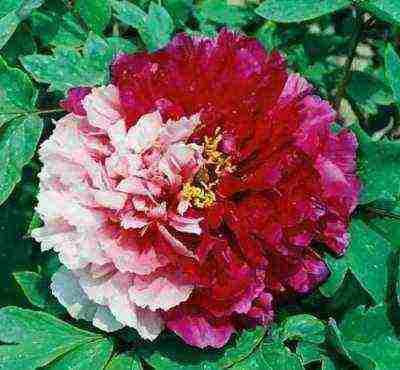 Unusual bicolor bud
Unusual bicolor bud
Average price:
740 RUB
Rating (2018):
4.9
"Sisters Kiao" - an amazing variety of peonies, combining two colors of the bud at once. As a rule, one half is purple-red and the other is cream-white. The diameter of the flower is 16 cm. The peony has an average height of 130 cm. Gardeners plant the Kiao Sisters as separate bushes or inside compositions. Judging by the reviews of gardeners, the variety is very resistant to various diseases.
Flowering usually occurs in June. The variety can grow in a wide variety of soils (Siberia, Moscow region), etc., but it will bloom better in sunny areas and alkaline, fertile soil. The Qiao Sisters are the perfect decoration for any garden. They are not whimsical to care for, they are resistant to different climates. The advantages include beautiful two-color buds, ease of care, resistance to disease and cold, many excellent reviews.
The best varieties of ITO-peonies
Many gardeners prefer this particular type of peonies. Ito hybrids are considered to be something between herbaceous and tree-like. They were bred by selection and incorporate the best qualities of each species. Before wintering, the aboveground part of such plants dies off, and grows back with the arrival of heat. The growth of the bush can reach 100 cm. The buds are large enough. Depending on the variety, ITO hybrids also differ in appearance. Such peonies are not whimsical to care for, do not require increased attention, but at the same time they decorate the territory. Below are the best ITO peonies with descriptions and photos.
2 Barthzella 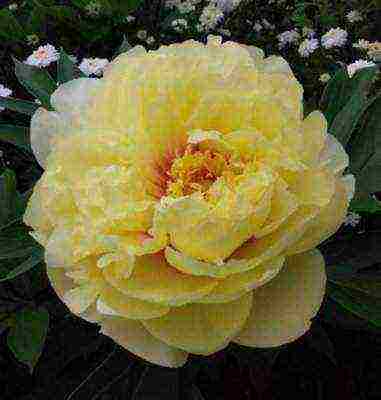 Long flowering time, bright buds
Long flowering time, bright buds
Average price:
RUB 700
Rating (2018):
4.8
"Bartzella" is an amazing variety of hybrid peonies with huge bright flowers. He is the winner of many prestigious competitions and is quite popular. The diameter of each bud is 25 cm. The intense yellow color at the core is replaced by a delicate cream at the edges. This combination looks advantageous against the background of rich green foliage. Some flowers have bright red streaks on individual petals, which makes their appearance even more beautiful. The aroma here is also unusual - instead of the usual floral scent during the flowering of "Bartzella" you can hear citrus notes.
Peony blooms at the end of June and lasts a whole month. Often the variety is used for cutting, in this form they are many times more expensive than the classic ones. The maximum height of the bushes is 100 cm.Without any shelter, they are able to survive the cold winter (for example, in the Moscow region and other regions of Russia). Advantages: long flowering period, unusual smell, bright shade, large-diameter buds, frost resistance.
1 Pastel Splendor  A large number of flowers on one bush
A large number of flowers on one bush
Average price:
1400 RUB
Rating (2018):
4.9
ITO-hybrid "Pastel Splendor" outwardly looks very aesthetically pleasing and neat. The bush does not exceed 70 cm in height, has a compact size and thick stems. The bright green foliage goes well with the delicate color of the flowers. They have white, cream and pink petals. The core is usually bright yellow, which gives a special "zest". During flowering, it fills the area with a light pleasant aroma. Another important feature is that one bush can form and sustain about 70 buds. The diameter of each is 17 cm.
After planting, the peony grows in one place for about 10 years. Created not only for growing in the garden, but also for complementing flower and bouquet compositions. Looks equally beautiful there and there. Flowering time falls in May-July. Intense growth requires a sunny area and regular watering after. Main advantages: a large number of buds on one bush, fast growth, compact size, powerful stems. Disadvantages: high cost.
Attention! The above information is not a buying guide. For any advice, you should contact the specialists!
 Two hundred years before the beginning of our era, luxurious peonies were admired by members of the Chinese imperial family and their courtiers. The best varieties of tree peonies that today adorn squares, parks and botanical gardens are distant descendants of plants from the Middle Kingdom, as well as hybrids obtained artificially and as a result of cross-pollination in natural conditions.
Two hundred years before the beginning of our era, luxurious peonies were admired by members of the Chinese imperial family and their courtiers. The best varieties of tree peonies that today adorn squares, parks and botanical gardens are distant descendants of plants from the Middle Kingdom, as well as hybrids obtained artificially and as a result of cross-pollination in natural conditions.
Classification of varieties of tree peonies
For two thousand years, tree peonies have become even more magnificent, brighter and more graceful. At the disposal of modern florists there are about 1000 varieties with corollas of different shapes and shades. Most of them are varieties of Chinese origin, resulting from the work of breeders:
- north of Central China;
- southeastern provinces of the country;
- coastal areas of the Yangtze River;
- northwestern regions of the PRC.
Based on this vast group and perennial species, the best varieties of tree peonies from Europe, the USA and Japan have been bred. Thanks to the efforts of many enthusiasts, the world collection of peonies has been replenished with specimens with original flowers of lilac, yellow, green shades.
Hu Lan tree peony (Hubei blue) - classic cultivar from Hubei province

In the gardens, you can see spectacular plants with variegated petals and corollas reminiscent of pompons, chrysanthemums or lotuses.
When obtaining unique varieties, flower growers of the New and Old Worlds, like their Chinese colleagues, prefer terry tree-like peonies with the largest, dense corollas. These varieties are incredibly effective and are incredibly loved by flower growers. However, there are other peonies as well.
Japanese tree peony
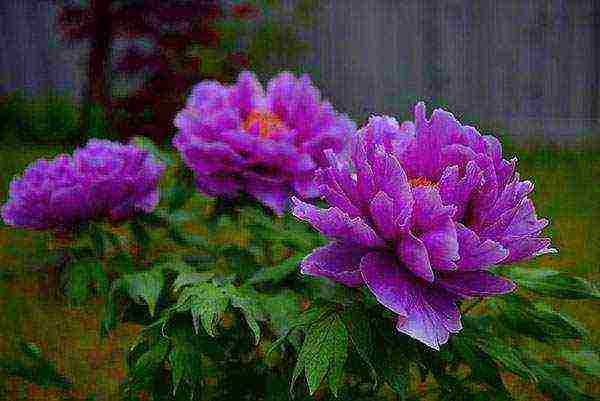 Breeders from the Land of the Rising Sun, following traditional ideas of beauty, have created a whole group of Japanese tree peonies with non-double and semi-double flowers. These varieties amaze with their elegance, lightness, exquisite shapes and a variety of colors.
Breeders from the Land of the Rising Sun, following traditional ideas of beauty, have created a whole group of Japanese tree peonies with non-double and semi-double flowers. These varieties amaze with their elegance, lightness, exquisite shapes and a variety of colors.
Varieties of white tree peonies
White is considered a symbol of purity, freshness and solemnity. It is not surprising that to see the flowering of snow-white peonies in your garden is the cherished desire of every fan of these plants. However, due to the natural characteristics of the culture, it is almost impossible to achieve absolute whiteness of the corollas.
The core of white peonies with a crown of stamens has a golden yellow color, and pink or purple-crimson strokes remain at the base of the petals.
Tree Peony Xue Ta (Snow Tower)
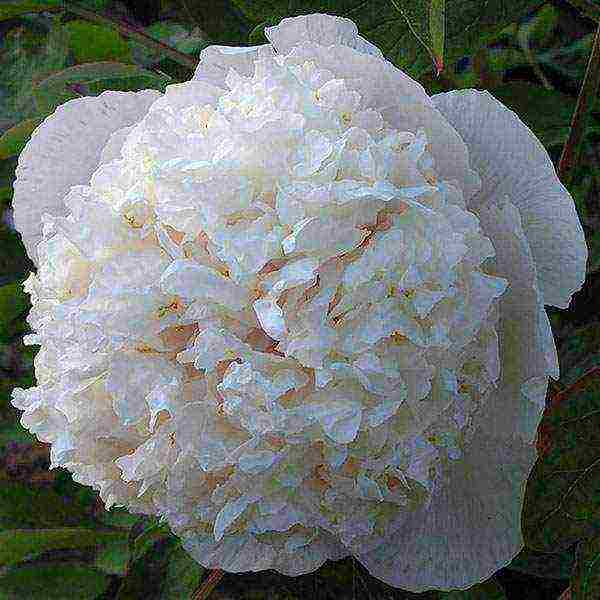 And yet, white tree peonies exist. The popular Chinese cultivar Xue Ta, Snow Tower, or Snow Pagoda are great examples. This is a perennial shrub that blooms for the first time at the age of 5–7 and reaches a height of 150 cm by the age of 10.
And yet, white tree peonies exist. The popular Chinese cultivar Xue Ta, Snow Tower, or Snow Pagoda are great examples. This is a perennial shrub that blooms for the first time at the age of 5–7 and reaches a height of 150 cm by the age of 10.
The medium-flowering plant is easily recognizable by its double flowers, reminiscent of garden roses or anemones. The petals, white at the edges, have a noticeable pinkish or peach shade at the base. Thanks to the rather stiff stems, even fully open corollas up to 16 cm in diameter do not fall and adorn a lush green bush for several days.
Tree Peony White Jade
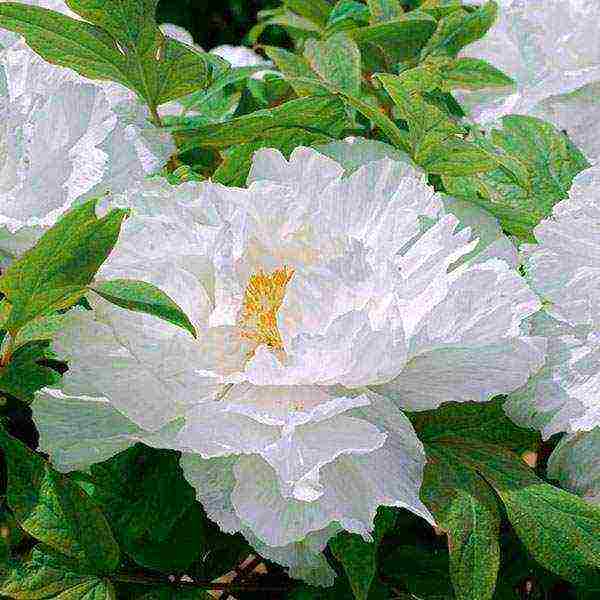 Another variety that has attracted the attention of flower growers from time immemorial is the tree-like peony White jade depicted in the photo with snow-white semi-double flowers and a golden crown of their numerous stamens.
Another variety that has attracted the attention of flower growers from time immemorial is the tree-like peony White jade depicted in the photo with snow-white semi-double flowers and a golden crown of their numerous stamens.
The ancient variety, called Yu Ban Bai in China, is considered one of the whitest. However, he won love not only with a unique shade of flowers. The lotus-like flowers reach 17 cm in diameter. They are clearly visible against the background of the dark green carved foliage. Thanks to the tough peduncles, peonies look great in a bouquet. Their light, sweet aroma subtly creates the mood of spring and joy.
Treelike peony variety White Phoenix
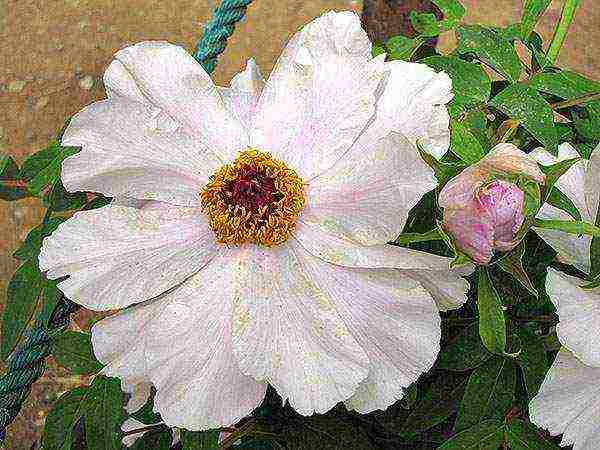 The best varieties of tree peonies include White Phoenix or Feng Dan Bai. A plant with white or slightly pinkish flowers of a simple form is distinguished by a high growth rate and rapid maturation. Large corollas with silky petals open above the foliage before buds appear on other varieties of peony. Therefore, the variety is appreciated not only for its decorative qualities, but also as an excellent rootstock for other varieties.
The best varieties of tree peonies include White Phoenix or Feng Dan Bai. A plant with white or slightly pinkish flowers of a simple form is distinguished by a high growth rate and rapid maturation. Large corollas with silky petals open above the foliage before buds appear on other varieties of peony. Therefore, the variety is appreciated not only for its decorative qualities, but also as an excellent rootstock for other varieties.
Peony tree Scent Lily
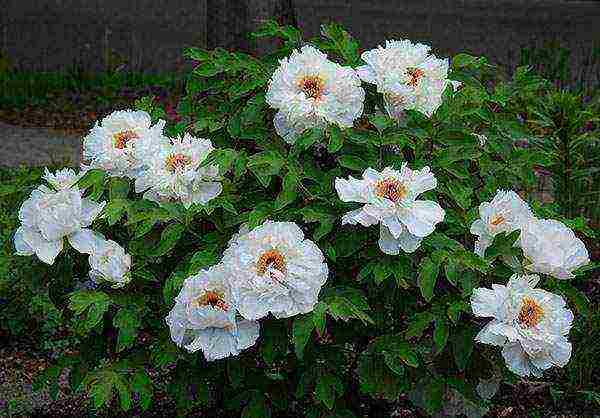 The previous variety, upon first acquaintance, can be easily confused with a tree-like peony. The smell of a lily, the characteristics of the variety and the appearance of which are very close.
The previous variety, upon first acquaintance, can be easily confused with a tree-like peony. The smell of a lily, the characteristics of the variety and the appearance of which are very close.
A tall, large plant with white, fragrant flowers will brighten any landscape. Decorative cores in golden and crimson tones give the semi-double rims a special charm and volume.
Red varieties of tree peonies
The most spectacular varieties of tree peonies from around the world will help to decorate the garden with ardent crimson-red shades.
Tree peony coral altar
 On the petals of the tree-like peony Coral Altar or Shan hu tai, as the name of the variety sounds in Chinese, pink, scarlet, coral-orange shades are exquisitely shimmering. At the edges, the tones brighten noticeably, and towards the base they become as saturated as possible, almost burgundy.
On the petals of the tree-like peony Coral Altar or Shan hu tai, as the name of the variety sounds in Chinese, pink, scarlet, coral-orange shades are exquisitely shimmering. At the edges, the tones brighten noticeably, and towards the base they become as saturated as possible, almost burgundy.
 Serrated petals crimped in the center are collected in terry corollas up to 15–20 cm in diameter. Peonies are held above the foliage by thin rigid stems. Large flowers with a slight sweetish aroma and relatively small. Bushes up to 150 cm in height make the variety very attractive for landscaping personal plots.
Serrated petals crimped in the center are collected in terry corollas up to 15–20 cm in diameter. Peonies are held above the foliage by thin rigid stems. Large flowers with a slight sweetish aroma and relatively small. Bushes up to 150 cm in height make the variety very attractive for landscaping personal plots.
Shima Nishiki terry tree peony variety
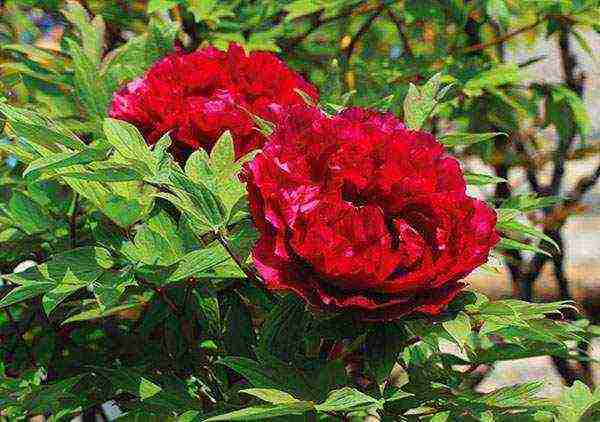
One of the first places in the popularity rating of red peonies is occupied by varieties of Japanese selection. Local enthusiasts offer both solid and incredible two-tone varieties.
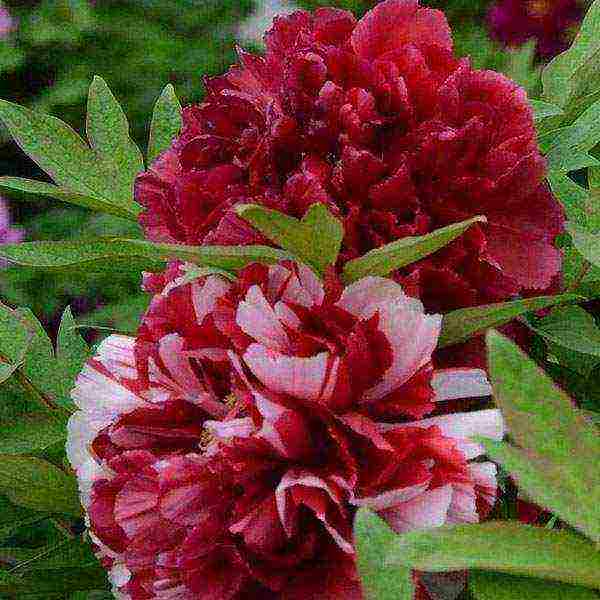 Thanks to a spontaneous mutation, noticed by botanists on the bushes of the red treelike peony Taiyo, the stunning and iconic Shima Nishiki was born in 1974. It is easy to recognize by its variegated petals, combining stripes and strokes of rich red and delicate, almost white color.
Thanks to a spontaneous mutation, noticed by botanists on the bushes of the red treelike peony Taiyo, the stunning and iconic Shima Nishiki was born in 1974. It is easy to recognize by its variegated petals, combining stripes and strokes of rich red and delicate, almost white color.
Spectacular Dao Jin Peony Flower
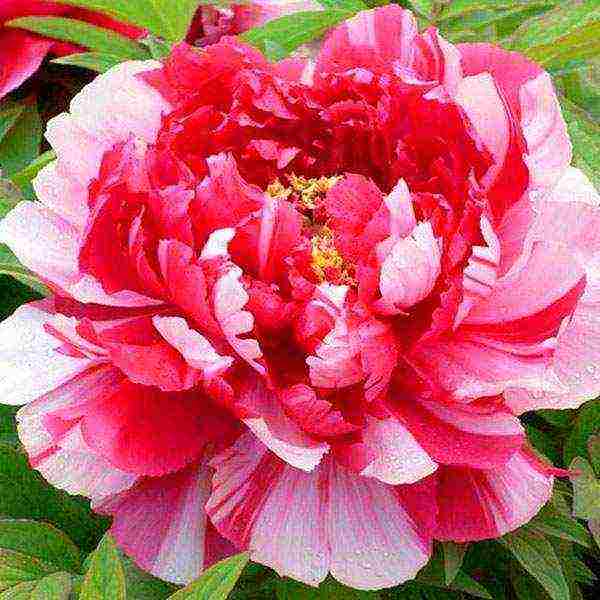 The beauty of the Japanese peony has served to spread it beyond the Land of the Rising Sun. The Chinese counterpart was named Dao Jin. A plant with giant, magical 25 cm semi-double flowers will be a shining star of any garden.
The beauty of the Japanese peony has served to spread it beyond the Land of the Rising Sun. The Chinese counterpart was named Dao Jin. A plant with giant, magical 25 cm semi-double flowers will be a shining star of any garden.
Treelike peony Hinode Sekai (Japan)
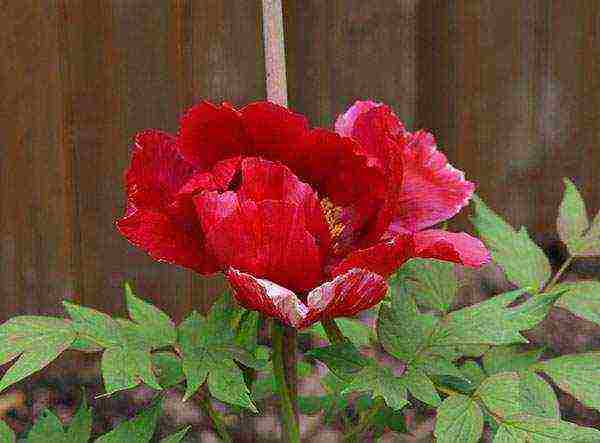 For small areas where there is no room for large one and a half meter shrubs, the magnificent Hinode Sekai, or World of the Rising Sun, is suitable. This is a natural dwarf of Japanese breeding.It reaches a height of 90–120 cm. Decorated with simple bright red or semi-double flowers without a scent.
For small areas where there is no room for large one and a half meter shrubs, the magnificent Hinode Sekai, or World of the Rising Sun, is suitable. This is a natural dwarf of Japanese breeding.It reaches a height of 90–120 cm. Decorated with simple bright red or semi-double flowers without a scent.
Purple, violet, lilac varieties of tree peonies
Florists are often faced with an offer to purchase purple, blue or blue peonies. In order not to be disappointed after such a purchase, it is important to know that peony petals cannot be painted in tones of heavenly blue.
Only with complete dissolution, light lilac, purple, bluish shades appear on the flowers.
Peony deep blue sea
 An example is the tree-like peony known to Russian flower growers, the Deep Blue Sea of an average flowering period. Shrubs with carved foliage can hold up to 50 large semi-double flowers with a yellow center and purple-red petals. When flowering, lasting up to two weeks, ends, the plants do not lose their decorative effect. The green, multiple dissected leaves remain fresh until the frost.
An example is the tree-like peony known to Russian flower growers, the Deep Blue Sea of an average flowering period. Shrubs with carved foliage can hold up to 50 large semi-double flowers with a yellow center and purple-red petals. When flowering, lasting up to two weeks, ends, the plants do not lose their decorative effect. The green, multiple dissected leaves remain fresh until the frost.
Anyone who is not indifferent to the flowers of a thick purple hue will be interested in the description of the Imperial Crown tree-like peony variety.
Peony Guan Qun Fang (Imperial crown)
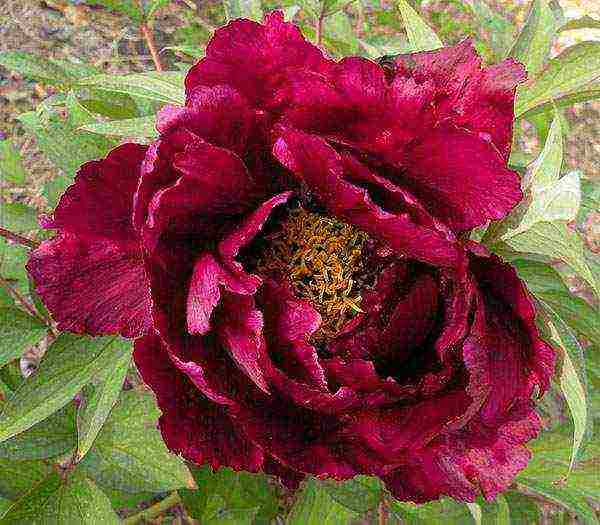 At home, in China and around the world, the plant with deep purple flowers resembling a tall crown is known as Guan Qun Fang. Spectacular, brocade-like corollas are clearly visible against the background of bright green foliage. Flowering takes place in the first half of summer, lasts from 10 to 14 days. If the Imperial Crown tree peony plant is provided with winter shelter and proper summer care, the peony blooms profusely and regularly, while the flowers do not fade for a long time and are excellent for cutting.
At home, in China and around the world, the plant with deep purple flowers resembling a tall crown is known as Guan Qun Fang. Spectacular, brocade-like corollas are clearly visible against the background of bright green foliage. Flowering takes place in the first half of summer, lasts from 10 to 14 days. If the Imperial Crown tree peony plant is provided with winter shelter and proper summer care, the peony blooms profusely and regularly, while the flowers do not fade for a long time and are excellent for cutting.
Roca Peony (Paeonia rockii) Purple Ocean
 The classic Chinese varieties of peonies have not lost their appeal today. At the beginning of the last century, unpretentious, but absolutely luxurious shrubs of the tree-like peony Purple Ocean appeared in European gardens. The cultivar, belonging to the Paeonia rockii variety, was also liked in Russia. This is a welcome gift for every fan of peonies, but not everyone is able to find a seedling.
The classic Chinese varieties of peonies have not lost their appeal today. At the beginning of the last century, unpretentious, but absolutely luxurious shrubs of the tree-like peony Purple Ocean appeared in European gardens. The cultivar, belonging to the Paeonia rockii variety, was also liked in Russia. This is a welcome gift for every fan of peonies, but not everyone is able to find a seedling.
The Purple Ocean peony stands out with large flowers up to 16 cm in diameter and up to 13 cm in height. The petals of dark purple tones are decorated with thin white or pink strokes extending from the base of the corolla to the edges.
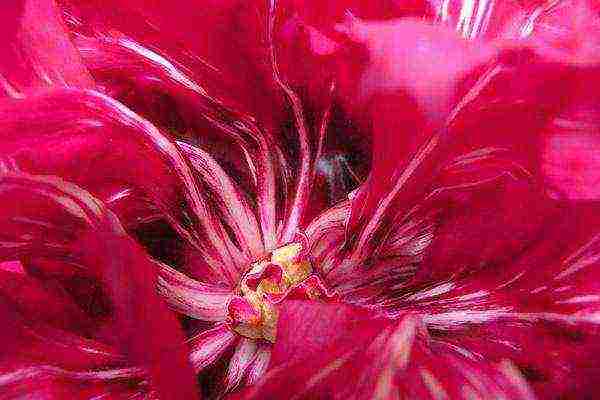 Peony blossoms, called Zi Hai Yin Bo in China, begins in the last days of May and ends by mid-June.
Peony blossoms, called Zi Hai Yin Bo in China, begins in the last days of May and ends by mid-June.
Interestingly, on young plants of the imperial crown peony, the flowers are often lotus-shaped. As it grows up, the bush is covered with dense terry corollas.
The flowers emanate a sweet aroma with notes of fruits and spices. This makes the variety one of the most fragrant. Shrubs of purple treelike peony up to one and a half meters high are very hardy. With minimal cover they overwinter in central Russia.
Pink tree peonies
Delicate, bright, exciting and passionate peonies with pink flowers of different shades are the basis of any collection of these amazing plants.
Blooming Peony Blue Sapphire (Lan bao shi)
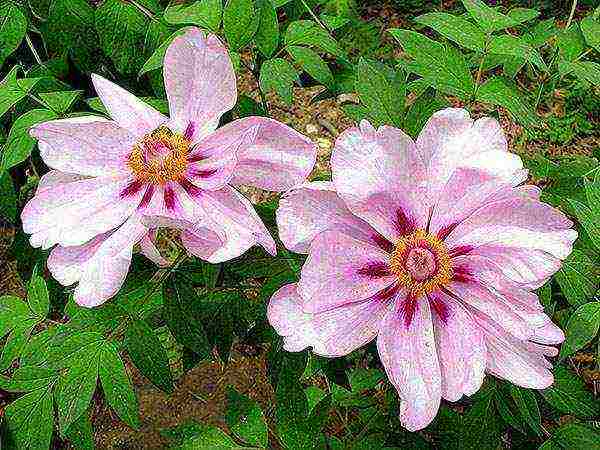 The tree-like peony Blue Sapphire shown in the photo is recognized as one of the best blue varieties. At the same time, the petals of large, simple-shaped flowers have a pale pink color, and azure highlights on them appear only towards the end of flowering. Plants grow rapidly and bloom profusely, by mid-June, covered with dozens of fragrant corollas with a diameter of 15 to 25 cm.
The tree-like peony Blue Sapphire shown in the photo is recognized as one of the best blue varieties. At the same time, the petals of large, simple-shaped flowers have a pale pink color, and azure highlights on them appear only towards the end of flowering. Plants grow rapidly and bloom profusely, by mid-June, covered with dozens of fragrant corollas with a diameter of 15 to 25 cm.
Sister Kiao's tree peony
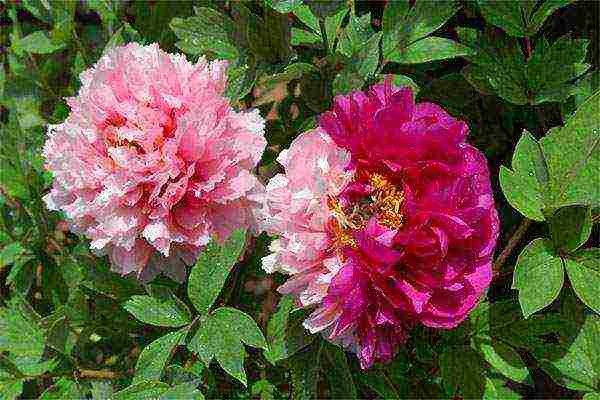 The peony of Sister Qiao, shown in the photo, is especially loved by flower growers in China. Shrubs up to 130 cm high in June are covered with unusual flowers, on the petals of which there are soft pink, almost white and crimson tones. Thanks to its unique feature, one shrub can create a striking accent in any corner of the garden.
The peony of Sister Qiao, shown in the photo, is especially loved by flower growers in China. Shrubs up to 130 cm high in June are covered with unusual flowers, on the petals of which there are soft pink, almost white and crimson tones. Thanks to its unique feature, one shrub can create a striking accent in any corner of the garden.
The origin of the variety is unknown, but it is invariably associated with the folk legend of the brave beauties.When a black dragon attacked a small village, only the Kiao sisters were not afraid to go out to battle with the monster. For nine days and nights, hiding under a mat in a rice field, they watched the villain. Then they killed the dragon that sat down on the crops. Unfortunately, the sisters died in the battle. The peasants buried them, and a year later a peony bush with recognizable two-color corollas appeared on the grave.
Tree peony Fen he piao jiang
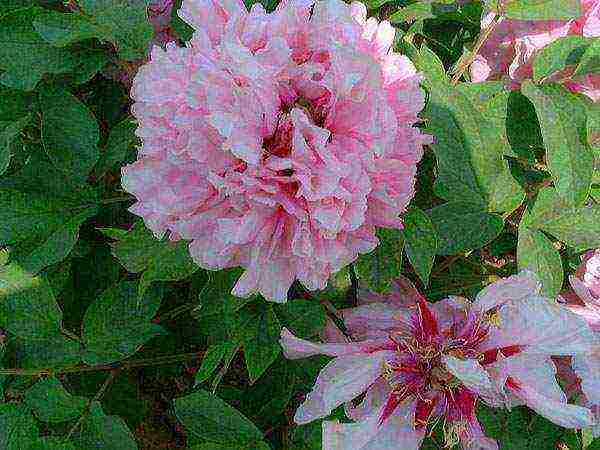 Undemanding to care and soil, effective and reliable variety. Such epithets can be heard in the address of the tree-like peony Pink River. Early flowering plants are characterized by rapid growth and abundant flowering. In early June, shrubs of one and a half meters in height are covered with flowers that resemble magnificent pink lotuses.
Undemanding to care and soil, effective and reliable variety. Such epithets can be heard in the address of the tree-like peony Pink River. Early flowering plants are characterized by rapid growth and abundant flowering. In early June, shrubs of one and a half meters in height are covered with flowers that resemble magnificent pink lotuses.
In the description of the tree-like peony Pink River, there is the Chinese name Fen he piao jiang and another translation into Russian - Pink powder. Both the first and second names emphasize the splendor of the flowering of the decorative perennial.
Peony Lantian Jay
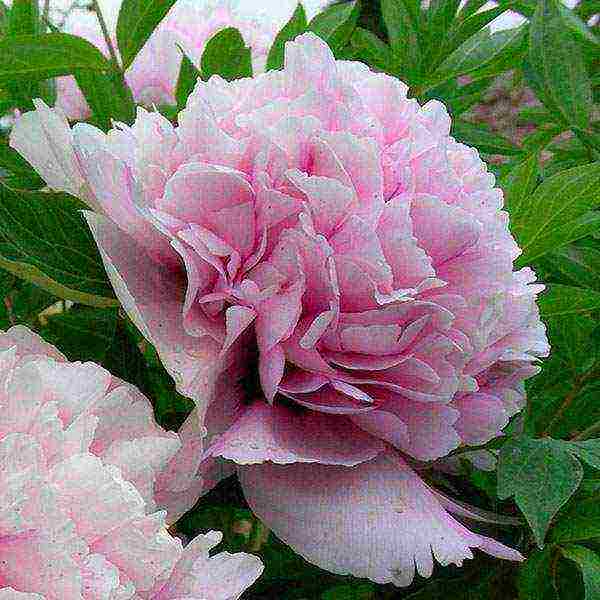 Lovers of lush double flowers will be fascinated by the tree-like peony Lantian Jay or Lan tian yu, as the plant is called in the PRC. In early summer, the plant, up to 120 cm high, is covered with fragrant flowers of an exquisite mauve shade.
Lovers of lush double flowers will be fascinated by the tree-like peony Lantian Jay or Lan tian yu, as the plant is called in the PRC. In early summer, the plant, up to 120 cm high, is covered with fragrant flowers of an exquisite mauve shade.
It was this unique tone that provided the variety with the name better known to Russian flower growers - the tree-like peony Blue Doe. The scalloped petals are intricately crimped and gathered into a kind of dense pompom. In the lower part of the corolla, the petals are much wider, which makes the plant look like a close relative, the herbaceous peony.
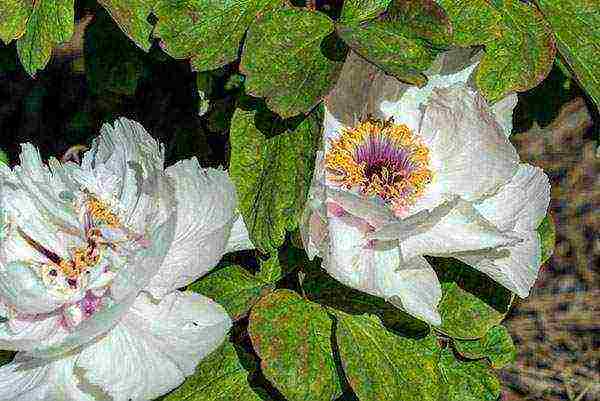 The above photo is Lantian Jay peony. This is a classic Chinese variety of a dwarf form acquired when grown in Japan.
The above photo is Lantian Jay peony. This is a classic Chinese variety of a dwarf form acquired when grown in Japan.
Peony Pink Zhao (Zhao fen)
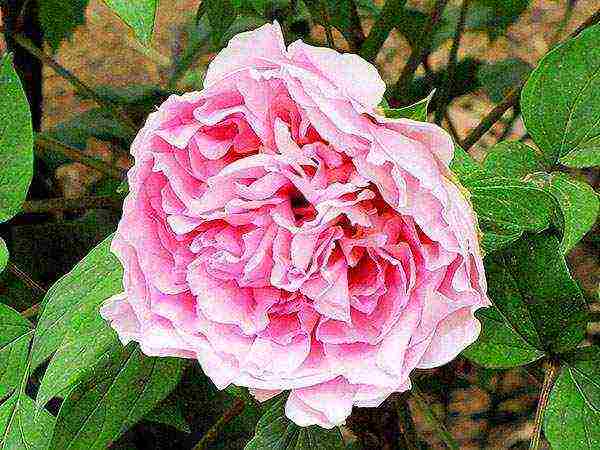 Large pink crown-shaped flowers are a characteristic feature of the tree-like peony Pink Zhao. Corollas of delicate colors reach 18 cm in diameter and 8 cm in height. Due to the severity of the flowers, even strong stems are slightly inclined, giving the bush a drooping appearance.
Large pink crown-shaped flowers are a characteristic feature of the tree-like peony Pink Zhao. Corollas of delicate colors reach 18 cm in diameter and 8 cm in height. Due to the severity of the flowers, even strong stems are slightly inclined, giving the bush a drooping appearance.
Zhao fen is one of the oldest cultivated varieties. The peony blooms in early June, filling the garden with a wondrous scent of lush corollas.
Peony Twin Beauty
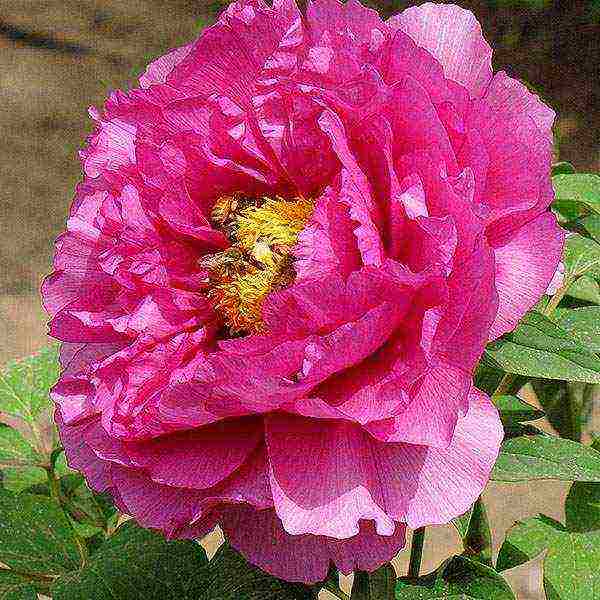 The tree-like peony Gemini, in the photo, is sometimes referred to as Two Beauties, Twin Beauty or Zi er qiao. The terry flower of this variety is characterized by the shape of a park rose and colors in carmine, red or crimson tones. The rim diameter is 14 cm, the height is 6 cm. At the stage of complete dissolution, a yellow core is noticeable. The narrow carved leaves, although they do not acquire brightness in autumn, are very decorative. Tuberous perennial peonies are also grown in the garden.
The tree-like peony Gemini, in the photo, is sometimes referred to as Two Beauties, Twin Beauty or Zi er qiao. The terry flower of this variety is characterized by the shape of a park rose and colors in carmine, red or crimson tones. The rim diameter is 14 cm, the height is 6 cm. At the stage of complete dissolution, a yellow core is noticeable. The narrow carved leaves, although they do not acquire brightness in autumn, are very decorative. Tuberous perennial peonies are also grown in the garden.
Yellow treelike peony varieties
 It was possible to obtain varieties of tree peony with yellow, orange, pinkish-peach flowers thanks to interspecific crossing.
It was possible to obtain varieties of tree peony with yellow, orange, pinkish-peach flowers thanks to interspecific crossing.
Kinko, or Jin Huang, as it is called in China, is a popular yellow tree peony. From a photo of a peony, it is easy to appreciate the charm and freshness of the flowers.
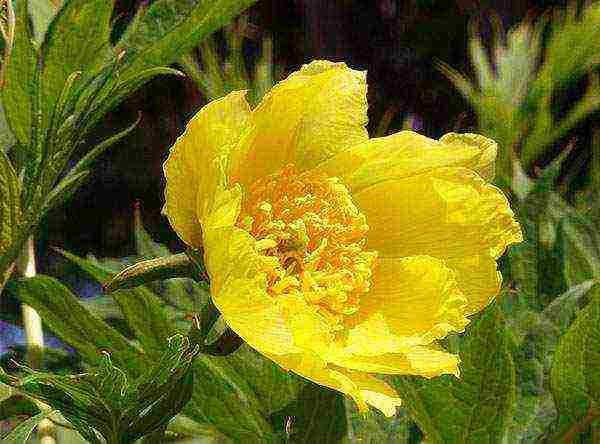 The European name of the plant, Alice Harding, received the peony in 1935 from its creator Victor Lemoine from France. Flowers of a lemon-yellow tone were obtained by crossing the natural yellow tree peony P. lutea shown in the photo and the Yaso-okina variety from Japan.
The European name of the plant, Alice Harding, received the peony in 1935 from its creator Victor Lemoine from France. Flowers of a lemon-yellow tone were obtained by crossing the natural yellow tree peony P. lutea shown in the photo and the Yaso-okina variety from Japan.
The Lemoine variety is characterized by late flowering, a sweet lemon aroma and compact size. At 10 years old, the height of the bush does not exceed 100 cm.
Peony Green Ball (Lu Mu Ying Yu)
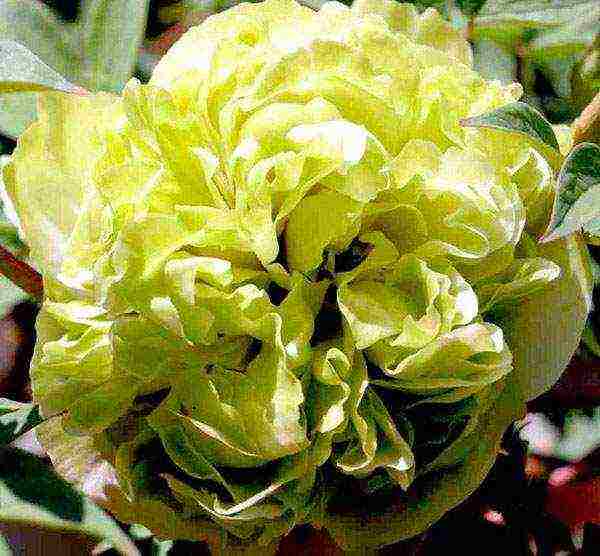 Skillfully using the natural features of the plant, Chinese breeders have created a variety, the flowers of which are first colored in light green tones, and then suddenly turn pinkish green.
Skillfully using the natural features of the plant, Chinese breeders have created a variety, the flowers of which are first colored in light green tones, and then suddenly turn pinkish green.
This is the tree-like peony Green ball depicted in the photo with dense double flowers, which provided the plant with an unusual name and memorable appearance. In Chinese catalogs, the variety is called Lu Mu Ying Yu, Green Jade, or Green Jade. A bush with a height of 150 to 180 cm in June, during flowering is clearly visible from any corner of the garden.
Tree peony Chan Liu (Spring willow)
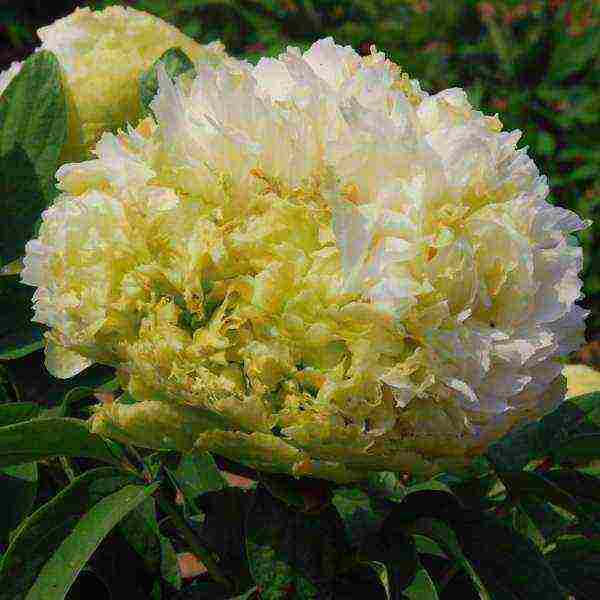 A rare but highly demanded variety of Chun Liu or Spring Willow. A plant no less spectacular than the Green Ball tree peony. Differs in dense buds with light green or yellowish petals. Closer to the base, they are decorated with crimson specks.
A rare but highly demanded variety of Chun Liu or Spring Willow. A plant no less spectacular than the Green Ball tree peony. Differs in dense buds with light green or yellowish petals. Closer to the base, they are decorated with crimson specks.
Tree peony sunrise
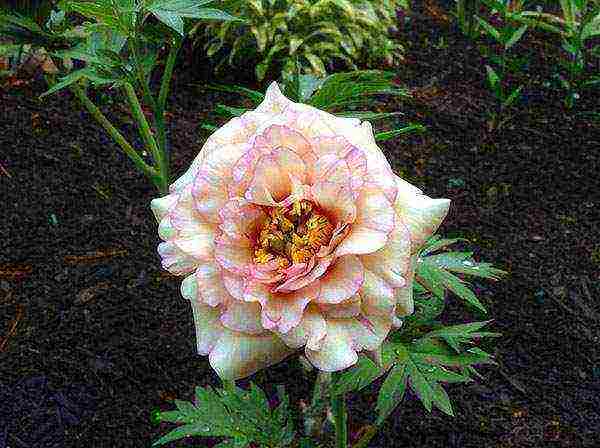 The tree-like peony Sunrise shown in the photo was created thanks to the efforts of David Reath in the United States. The hybrid plant, obtained from Peony Lutea, annually pleases owners with yellow-pink semi-double flowers with gracefully twisted petals and a crown of yellow stamens at the core.
The tree-like peony Sunrise shown in the photo was created thanks to the efforts of David Reath in the United States. The hybrid plant, obtained from Peony Lutea, annually pleases owners with yellow-pink semi-double flowers with gracefully twisted petals and a crown of yellow stamens at the core.
The tree-like peony Voskhod or Sunrise demonstrates the maximum decorative effect in sunny areas. Carmine border on creamy yellow petals accentuates the splendor of the flower.
Kinkaku tree peony
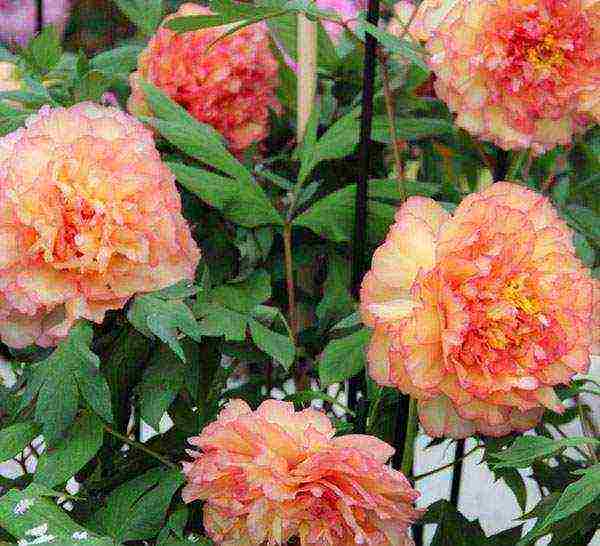 Among the most popular varieties, the Kinko tree peony occupies one of the most honorable places. The plant, presented in foreign catalogs as the Kinkaku peony, stands out with orange-yellow double flowers. The light yellow background color of the petals refreshes the soft, like watercolor carmine border, creating a blush effect. The peculiarity of the variety is heavy flowers, hanging a little on thin stems and massively opening in early June.
Among the most popular varieties, the Kinko tree peony occupies one of the most honorable places. The plant, presented in foreign catalogs as the Kinkaku peony, stands out with orange-yellow double flowers. The light yellow background color of the petals refreshes the soft, like watercolor carmine border, creating a blush effect. The peculiarity of the variety is heavy flowers, hanging a little on thin stems and massively opening in early June.
Treelike peonies bloom in the garden - video


